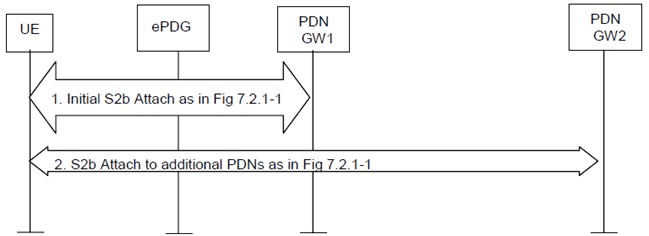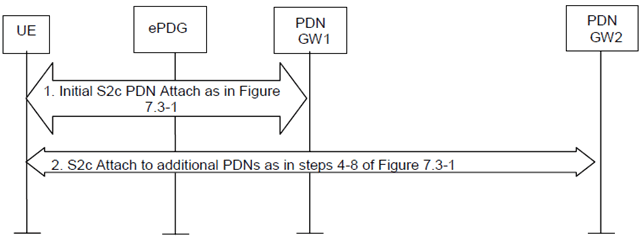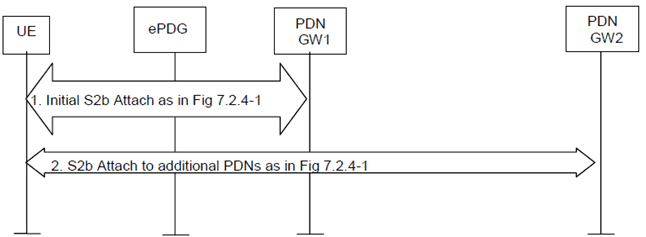Content for TS 23.402 Word version: 18.3.0
0…
4…
4.2…
4.2.2
4.2.3
4.3…
4.4…
4.5…
4.5.7…
4.6…
4.7…
4.7.2…
4.8…
4.8.2a…
4.9…
5…
5.2…
5.4…
5.5
5.6…
5.7…
5.8…
6…
6.2…
6.3
6.4…
6.4.3…
6.5…
6.6…
6.7…
6.8…
6.10…
6.13…
6.15…
7…
7.2…
7.3
7.4…
7.5…
7.6…
7.8…
7.10…
8…
8.2.1.2
8.2.1.3…
8.2.2
8.2.3…
8.2.6…
8.3…
8.4…
8.5…
9…
9.3…
9.4…
10…
13…
16…
16.1.2…
16.1.6…
16.2…
16.2.1a…
16.3…
16.4…
16.7…
16.8…
16.10…
17…
A…
C…
E…
7.6 UE-initiated Connectivity to Additional PDN
7.6.1 UE-initiated Connectivity to Additional PDN with PMIPv6 on S2b
7.6.2 UE-initiated Connectivity to Additional PDN from Un-trusted Non-3GPP IP Access with DSMIPv6 on S2c
7.6.3 UE-initiated Connectivity to Additional PDN with GTP on S2b
...
...
7.6 UE-initiated Connectivity to Additional PDN p. 176
7.6.1 UE-initiated Connectivity to Additional PDN with PMIPv6 on S2b p. 176
This clause is related to the case when the UE has an established PDN connection over untrusted non-3GPP access with PMIPv6 on S2b and wishes to establish one or more additional PDN connections over such untrusted access. This procedure is also used to request for connectivity to an additional PDN over untrusted non-3GPP access with PMIPv6 on S2b when the UE is simultaneously connected to such untrusted access and a 3GPP access, and the UE already has active PDN connections over both the accesses. Since PMIPv6 is used to establish connectivity with the additional PDN, the UE establishes a separate SWu instance (i.e. a separate IPSec tunnel) for each additional PDN.
There can be more than one PDN connection per APN if both the ePDG and the PDN-GW support that feature. When multiple PDN connections to a given APN are supported, during the establishment of a new PDN connection, the ePDG creates and sends a PDN Connection identity to the PDN-GW. The PDN connection identity is unique in the scope of the UE and the APN within an ePDG, i.e. the MN-ID, the APN, and the PDN connection identity together identify a PDN connection within an ePDG. In order to be able to identify a specific established PDN connection, both the ePDG and the PDN-GW shall store the PDN Connection identity. Sending the PDN connection identity is an indication that the ePDG supports multiple PDN connections to a single APN and the PDN-GW shall be able to indicate if it supports multiple PDN connections to a single APN. Between the UE and the ePDG the IPSec SA associated with the PDN connection identifies the PDN connection.

Figure 7.6.1-1: UE-initiated connectivity to additional PDN from Un-trusted Non-3GPP IP Access with PMIPv6
(⇒ copy of original 3GPP image)
(⇒ copy of original 3GPP image)
Step 1.
The UE has performed the Initial S2b Attach procedure as defined in clause 7.2.1, Figure 7.2.1-1 and has an established PDN connection.
Step 2.
The UE repeats the procedure of clause 7.2.1, Figure 7.2.1-1 for each additional PDN the UE wants to connect to, with the following exceptions:
- The IKEv2 tunnel establishment procedure for each additional PDN connection is initiated with the ePDG that was selected in step 1;
- The APN information corresponding to the requested PDN connection is conveyed with IKEv2 as specified in TS 33.402;
- For network supporting multiple mobility protocols, if there was any dynamic IPMS decision in step 1, the AAA/HSS enforces the same IPMS decision for each additional PDN connection.
7.6.2 UE-initiated Connectivity to Additional PDN from Un-trusted Non-3GPP IP Access with DSMIPv6 on S2c p. 177
This clause is related to the case when the UE powers-on in an untrusted network and host-based mobility management mechanism is used for obtaining connectivity. Dual Stack MIPv6, RFC 5555 is used for supporting mobility over S2c interface. This case covers the scenario when UE obtains connectivity with one or more additional PDNs at any time after initial attach Since host-based mobility mechanisms are used, the procedure is similar to the initial attach procedure. This procedure is also used to request for connectivity to an additional PDN over untrusted non-3GPP access with DSMIPv6 on S2c when the UE is simultaneously connected to such untrusted access and a 3GPP access, and the UE already has active PDN connections over both the accesses.

Figure 7.6.2-1: UE-initiated connectivity to additional PDN from Un-trusted Non-3GPP IP Access with DSMIPv6
(⇒ copy of original 3GPP image)
(⇒ copy of original 3GPP image)
When the initial attachment is performed, the UE performs procedures described in clause 7.3, Figure 7.3-1, to obtain connectivity with a PDN-GW and a specific PDN. If at any time the UE wants to obtain connectivity with additional PDNs, since DSMIPv6 is used to obtain connectivity, the UE repeats only steps 4-8 of Figure 7.3-1.
- The UE performs initial S2c PDN Attach procedure as defined in clause 7.3, Figure 7.3-1.
- The UE repeats steps 4-8 of clause 7.3, Figure 7.3-1 for each additional PDN the UE wants to connect to. This step can be performed and repeated at any time after step 1 for one or multiple PDNs.
7.6.3 UE-initiated Connectivity to Additional PDN with GTP on S2b |R10| p. 177
This clause is related to the case when the UE has an established PDN connection over untrusted non-3GPP access with GTP on S2b and wishes to establish one or more additional PDN connections over such untrusted access. This procedure is also used to request for connectivity to an additional PDN over untrusted non-3GPP access with GTP on S2b when the UE is simultaneously connected to such untrusted access and a 3GPP access, and the UE already has active PDN connections over both the accesses. Since GTP is used to establish connectivity with the additional PDN, the UE establishes a separate SWu instance (i.e. a separate IPSec tunnel) for each additional PDN.
There can be more than one PDN connection per APN when GTP is used between the ePDG and the PDN-GW. During the establishment of a new PDN connection, the ePDG allocates and sends a default EPS bearer ID to the PDN-GW. The default EPS bearer ID is unique in the scope of the UE within an ePDG, i.e. the IMSI and the default EPS bearer ID together identify a PDN connection within an ePDG. In order to be able to identify a specific established PDN connection, both the ePDG and the PDN-GW shall store the default EPS bearer ID. Between the UE and the ePDG the IPSec SA associated with the PDN connection identifies the PDN connection.
An UE attached for emergency services shall not initiate any additional PDN Connectivity Request procedure. An UE attached for regular services may request a PDN connection for emergency services if an emergency PDN connection is not already active.

Figure 7.6.3-1: UE-initiated connectivity to additional PDN from Un-trusted Non-3GPP IP Access with GTP
(⇒ copy of original 3GPP image)
(⇒ copy of original 3GPP image)
Step 1.
The UE has performed the Initial GTP based S2b Attach procedure as defined in clause 7.2.4, Figure 7.2.4-1 and has an established PDN connection.
Step 2.
The UE repeats the procedure of clause 7.2.4, Figure 7.2.4-1 for each additional PDN the UE wants to connect to, with the following exceptions:
- The IKEv2 tunnel establishment procedure for each additional PDN connection is initiated with the ePDG that was selected in step 1;
- The APN information corresponding to the requested PDN connection is conveyed with IKEv2 as specified in TS 33.402;
- For network supporting multiple mobility protocols, if there was any dynamic IPMS decision in step 1, the AAA/HSS enforces the same IPMS decision for each additional PDN connection.
- The UE shall add an emergency indication in IKE signalling in order to indicate that the EPC access is requested for emergency services;
- Any APN received by the ePDG from the UE shall be ignored as the ePDG shall use its Emergency Configuration Data to determine the APN and the QoS parameters to be associated with the emergency PDN connection and to determine the PDN-GW to use. The ePDG shall not check whether this APN is part of the subscription of the UE.
-
The ePDG shall add the location information it may have for the UE in the Create Session Request:
- WLAN Location Information it may have received from the AAA server for the UE;
- The UE local IP address, and optionally UDP source port number if NAT is detected.